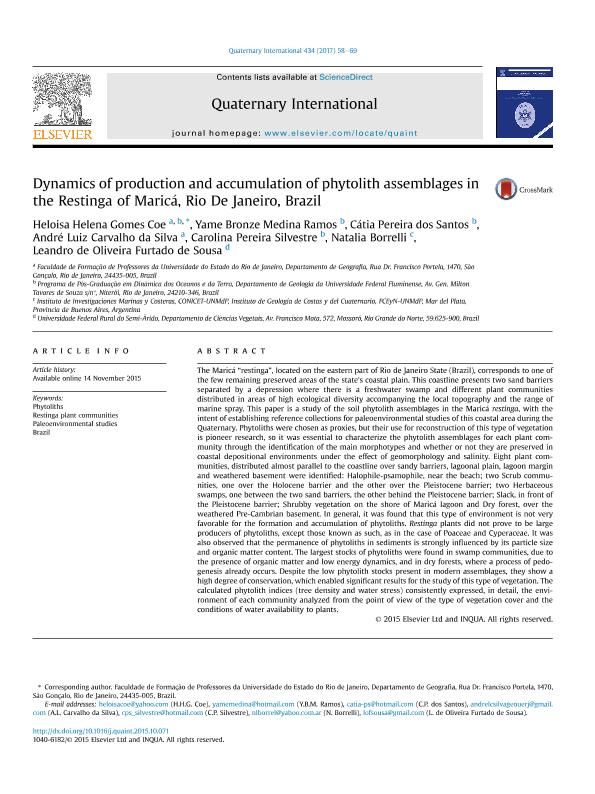Mostrar el registro sencillo del ítem
dc.contributor.author
Gomes Coe, Heloisa Helena
dc.contributor.author
Medina Ramos, Yame Bronze
dc.contributor.author
Pereira dos Santos, Catia
dc.contributor.author
Carvalho da Silva, André Luiz
dc.contributor.author
Pereira Silvestre, Carolina
dc.contributor.author
Borrelli, Natalia Lorena

dc.contributor.author
Furtado de Sousa, Leandro de Oliveira
dc.date.available
2018-11-14T12:56:14Z
dc.date.issued
2017-04-14
dc.identifier.citation
Gomes Coe, Heloisa Helena; Medina Ramos, Yame Bronze; Pereira dos Santos, Catia; Carvalho da Silva, André Luiz; Pereira Silvestre, Carolina; et al.; Dynamics of production and accumulation of phytolith assemblages in the Restinga of Maricá, Rio De Janeiro, Brazil; Pergamon-Elsevier Science Ltd; Quaternary International; 434; 14-4-2017; 58-69
dc.identifier.issn
1040-6182
dc.identifier.uri
http://hdl.handle.net/11336/64433
dc.description.abstract
The Maricá “restinga”, located on the eastern part of Rio de Janeiro State (Brazil), corresponds to one of the few remaining preserved areas of the state's coastal plain. This coastline presents two sand barriers separated by a depression where there is a freshwater swamp and different plant communities distributed in areas of high ecological diversity accompanying the local topography and the range of marine spray. This paper is a study of the soil phytolith assemblages in the Maricá restinga, with the intent of establishing reference collections for paleoenvironmental studies of this coastal area during the Quaternary. Phytoliths were chosen as proxies, but their use for reconstruction of this type of vegetation is pioneer research, so it was essential to characterize the phytolith assemblages for each plant community through the identification of the main morphotypes and whether or not they are preserved in coastal depositional environments under the effect of geomorphology and salinity. Eight plant communities, distributed almost parallel to the coastline over sandy barriers, lagoonal plain, lagoon margin and weathered basement were identified: Halophile-psamophile, near the beach; two Scrub communities, one over the Holocene barrier and the other over the Pleistocene barrier; two Herbaceous swamps, one between the two sand barriers, the other behind the Pleistocene barrier; Slack, in front of the Pleistocene barrier; Shrubby vegetation on the shore of Maricá lagoon and Dry forest, over the weathered Pre-Cambrian basement. In general, it was found that this type of environment is not very favorable for the formation and accumulation of phytoliths. Restinga plants did not prove to be large producers of phytoliths, except those known as such, as in the case of Poaceae and Cyperaceae. It was also observed that the permanence of phytoliths in sediments is strongly influenced by its particle size and organic matter content. The largest stocks of phytoliths were found in swamp communities, due to the presence of organic matter and low energy dynamics, and in dry forests, where a process of pedogenesis already occurs. Despite the low phytolith stocks present in modern assemblages, they show a high degree of conservation, which enabled significant results for the study of this type of vegetation. The calculated phytolith indices (tree density and water stress) consistently expressed, in detail, the environment of each community analyzed from the point of view of the type of vegetation cover and the conditions of water availability to plants.
dc.format
application/pdf
dc.language.iso
eng
dc.publisher
Pergamon-Elsevier Science Ltd

dc.rights
info:eu-repo/semantics/openAccess
dc.rights.uri
https://creativecommons.org/licenses/by-nc-sa/2.5/ar/
dc.subject
Brazil
dc.subject
Paleoenvironmental Studies
dc.subject
Phytoliths
dc.subject
Restinga Plant Communities
dc.subject.classification
Meteorología y Ciencias Atmosféricas

dc.subject.classification
Ciencias de la Tierra y relacionadas con el Medio Ambiente

dc.subject.classification
CIENCIAS NATURALES Y EXACTAS

dc.title
Dynamics of production and accumulation of phytolith assemblages in the Restinga of Maricá, Rio De Janeiro, Brazil
dc.type
info:eu-repo/semantics/article
dc.type
info:ar-repo/semantics/artículo
dc.type
info:eu-repo/semantics/publishedVersion
dc.date.updated
2018-10-23T14:08:19Z
dc.identifier.eissn
1873-4553
dc.journal.volume
434
dc.journal.pagination
58-69
dc.journal.pais
Estados Unidos

dc.journal.ciudad
Nueva York
dc.description.fil
Fil: Gomes Coe, Heloisa Helena. Universidade do Estado de Rio do Janeiro; Brasil. Universidade Federal Fluminense; Brasil
dc.description.fil
Fil: Medina Ramos, Yame Bronze. Universidade Federal Fluminense; Brasil
dc.description.fil
Fil: Pereira dos Santos, Catia. Universidade Federal Fluminense; Brasil
dc.description.fil
Fil: Carvalho da Silva, André Luiz. Universidade do Estado de Rio do Janeiro; Brasil
dc.description.fil
Fil: Pereira Silvestre, Carolina. Universidade Federal Fluminense; Brasil
dc.description.fil
Fil: Borrelli, Natalia Lorena. Consejo Nacional de Investigaciones Científicas y Técnicas. Centro Científico Tecnológico Conicet - Mar del Plata. Instituto de Investigaciones Marinas y Costeras. Universidad Nacional de Mar del Plata. Facultad de Ciencia Exactas y Naturales. Instituto de Investigaciones Marinas y Costeras; Argentina
dc.description.fil
Fil: Furtado de Sousa, Leandro de Oliveira. Universidade Federal Rural Do Semi-Arido; Brasil
dc.journal.title
Quaternary International

dc.relation.alternativeid
info:eu-repo/semantics/altIdentifier/url/https://www.sciencedirect.com/science/article/pii/S104061821501054X
dc.relation.alternativeid
info:eu-repo/semantics/altIdentifier/doi/https://dx.doi.org/10.1016/j.quaint.2015.10.071
Archivos asociados
